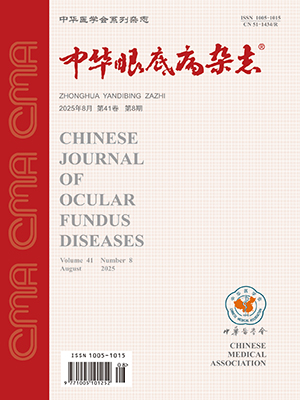| 1. |
Zeppieri M, Ameer MA, Jahngir MU, et al. Meige syndrome[M]. Treasure Island (FL): StatPearls Publishing, 2024.
|
| 2. |
Owecki MK, Bogusz H, Magowska A. Henri Meige (1866-1940)[J]. J Neurol, 2017, 264(11): 2348-2350. DOI: 10.1007/s00415-017-8575-z.
|
| 3. |
Teng X, Qu Q, Shu Y, et al. Genetic screening in patients of Meige syndrome and blepharospasm[J]. Neurol Sci, 2022, 43(6): 3683-3694. DOI: 10.1007/s10072-022-05900-8.
|
| 4. |
Ganguly J, Kulshreshtha D, Almotiri M, et al. Muscle tone physiology and abnormalities[J]. Toxins (Basel), 2021, 13(4): 282. DOI: 10.3390/toxins13040282.
|
| 5. |
Jinnah HA. Medical and surgical treatments for dystonia[J]. Neurol Clin, 2020, 38(2): 325-348. DOI: 10.1016/j.ncl.2020.01.003.
|
| 6. |
Quartarone A, Hallett M. Emerging concepts in the physiological basis of dystonia[J]. Mov Disord, 2013, 28(7): 958-967. DOI: 10.1002/mds.25532.
|
| 7. |
Liu B, Mao Z, Cui Z, et al. Cerebellar gray matter alterations predict deep brain stimulation outcomes in Meige syndrome[J/OL]. Neuroimage Clin, 2023, 37: 103316[2023-01-04]. https://pubmed.ncbi.nlm.nih.gov/36610311/. DOI: 10.1016/j.nicl.2023.103316.
|
| 8. |
Odorfer TM, Volkmann J. Deep brain stimulation for focal or segmental craniocervical dystonia in patients who have failed botulinum neurotoxin therapy-a narrative review of the literature[J]. Toxins (Basel), 2023, 15(10): 606. DOI: 10.3390/toxins15100606.
|
| 9. |
Mantel T, Jochim A, Meindl T, et al. Thalamic structural connectivity profiles in blepharospam/Meige's syndrome[J/OL]. Neuroimage Clin, 2022, 34: 103013[2022-04-22]. https://pubmed.ncbi.nlm.nih.gov/35483134/. DOI: 10.1016/j.nicl.2022.103013.
|
| 10. |
Ma H, Qu J, Ye L, et al. Blepharospasm, oromandibular dystonia, and Meige syndrome: clinical and genetic update[J/OL]. Front Neurol, 2021, 12: 630221[2021-03-29]. https://pubmed.ncbi.nlm.nih.gov/33854473/. DOI: 10.3389/fneur.2021.630221.
|
| 11. |
Tolosa ES. Clinical features of Meige's disease (idiopathic orofacial dystonia): a report of 17 cases[J]. Arch Neurol, 1981, 38(3): 147-151. DOI: 10.1001/archneur.1981.00510030041005.
|
| 12. |
Jankovic J, Havins WE, Wilkins RB. Blinking and blepharospasm. Mechanism, diagnosis, and management[J]. JAMA, 1982, 248(23): 3160-3164. DOI: 10.1001/jama.1982.03330230060037.
|
| 13. |
Berardelli A, Rothwell JC, Day BL, et al. Pathophysiology of blepharospasm and oromandibular dystonia[J]. Brain, 1985, 108 (Pt 3): 593-608. DOI: 10.1093/brain/108.3.593.
|
| 14. |
Ohtake T, Hirose K, Tanabe H. Surface electromyographic study of idiopathic cranial dystonia focused on the orbicularis oculi muscles[J]. J Neurol Sci, 1992, 110(1-2): 68-72. DOI: 10.1016/0022-510x(92)90011-9.
|
| 15. |
Sakai T, Shikishima K, Kawai K, et al. Meige's syndrome associated with basal ganglia and thalamic functional disorders[J]. Nippon Ganka Gakkai Zasshi, 1998, 102(11): 764-770.
|
| 16. |
黄筑忆, 苗素华, 左焕琮, 等. 神经电生理和MRTA检查在鉴别面肌痉挛和Meige综合征中应用价值的探讨[G]. 中华医学会神经病学分会第九届全国中青年神经病学学术会议论文集, 南京, 2016. 北京: 中华医学会神经病学分会, 2016: 26.Huang ZY, Miao SH, Zuo HZ, et al. Evaluation of the application value of electrophysiology and MRTA in differentiating hemifacial spasm from Meige syndrome[G]. Abstracts from the 9th National Conference on Neurology for Young and Middle-Aged Neurologists of Neurology Branch of the Chinese Medical Association, Nanjing, 2016. Beijing: Neurology Branch of the Chinese Medical Association, 2016: 26.
|
| 17. |
中华医学会眼科学分会神经眼科学组. 我国Meige综合征诊断和治疗专家共识(2018年)[J]. 中华眼科杂志, 2018, 54(2): 93-96. DOI: 10.3760/cma.j.issn.0412-4081.2018.02.005.Neuroophthalmology Group, Ophthalmology Society of Chinese Medical Association. Expert consensus on diagnosis and treatment of Meige syndrome in China(2018)[J]. Chin J Ophthalmol, 2018, 54(2): 93-96. DOI: 10.3760/cma.j.issn.0412-4081.2018.02.005.
|
| 18. |
Defazio G, Jinnah HA, Berardelli A, et al. Diagnostic criteria for blepharospasm: a multicenter international study[J]. Parkinsonism Relat Disord, 2021, 91: 109-114. DOI: 10.1016/j.parkreldis.2021.09.004.
|
| 19. |
Scorr LM, Cho HJ, Kilic-Berkmen G, et al. Clinical features and evolution of blepharospasm: a multicenter international cohort and systematic literature review[J/OL]. Dystonia, 2022, 1: 10359[2022-05-16]. https://pubmed.ncbi.nlm.nih.gov/36248010/. DOI: 10.3389/dyst.2022.10359.
|
| 20. |
Shorr N, Seiff SR, Kopelman J. The use of botulinum toxin in blepharospasm[J]. Am J Ophthalmol, 1985, 99(5): 542-546. DOI: 10.1016/s0002-9394(14)77954-1.
|
| 21. |
Tsubota K, Fujihara T, Kaido M, et al. Dry eye and Meige's syndrome[J]. Br J Ophthalmol, 1997, 81(6): 439-442. DOI: 10.1136/bjo.81.6.439.
|
| 22. |
Wakakura M, Yamagami A, Iwasa M. Blepharospasm in Japan: a clinical observational study from a large referral hospital in Tokyo[J]. Neuroophthalmology, 2018, 42(5): 275-283. DOI: 10.1080/01658107.2017.1409770.
|
| 23. |
徐瑱, 郭强英, 余尚益, 等. Meige综合征患者的早期临床特征分析[J]. 中华眼外伤职业眼病杂志, 2023, 45(4): 280-284. DOI: 10.3760/cma.j.cn116022-20230119-00025.Xu Z, Guo QY, Yu SY, et al. Analysis on the early clinical features of Meige syndrome[J]. Chin J Ocul Traum Occupat Eye Dis, 2023, 45(4): 280-284. DOI: 10.3760/cma.j.cn116022-20230119-00025.
|
| 24. |
Girard BC, Lévy P. Dry eye syndrome in benign essential blepharospasm[J]. J Fr Ophtalmol, 2019, 42(10): 1062-1067. DOI: 10.1016/j.jfo.2019.06.007.
|
| 25. |
梁凌毅, 李晶, 刘祖国. 关注功能性干眼[J]. 中华眼科杂志, 2019, 55(12): 885-890. DOI: 10.3760/cma.j.issn.0412-4081.2019.12.003.Liang LY, Li J, Liu ZG. Focusing on the funetional dry eye[J]. Chin J Ophthalmol, 2019, 55(12): 885-890. DOI: 10.3760/cma.j.issn.0412-4081.2019.12.003.
|
| 26. |
Jacob S. Treating myasthenia gravis beyond the eye clinic[J]. Eye (Lond), 2024, 38(12): 2422-2436. DOI: 10.1038/s41433-024-03133-x.
|
| 27. |
Sergeeva MS, Danilov SS, Sherbakova NI. Ocular myasthenia gravis[J]. Vestn Oftalmol, 2024, 140(4): 86-91. DOI: 10.17116/oftalma202414004186.
|
| 28. |
Katz BJ, Digre KB. Diagnosis, pathophysiology, and treatment of photophobia[J]. Surv Ophthalmol, 2016, 61(4): 466-477. DOI: 10.1016/j.survophthal.2016.02.001.
|
| 29. |
Dieckmann G, Goyal S, Hamrah P. Neuropathic corneal pain: approaches for management[J]. Ophthalmology, 2017, 124(11S): S34-47. DOI: 10.1016/j.ophtha.2017.08.004.
|
| 30. |
Dagostino S, Ercoli T, Gigante AF, et al. Sensory trick in upper limb dystonia[J]. Parkinsonism Relat Disord, 2019, 63: 221-223. DOI: 10.1016/j.parkreldis.2019.01.006.
|
| 31. |
刘小兰, 徐双双, 赵薇, 等. 梅杰综合征的临床诊疗进展[J]. 中华疼痛学杂志, 2022, 18(3): 419-423. DOI: 10.3760/cma.j.cn101658-20211109-00137.Liu XL, Xu SS, Zhao W, et al. Progress in diagnosis and treatment of Meige's syndrome[J]. Chin J Painol, 2022, 18(3): 419-423. DOI: 10.3760/cma.j.cn101658-20211109-00137.
|
| 32. |
刘刚, 徐瑱, 郭强英, 等. 神经环路阻断术治疗Meige综合征眼睑痉挛的效果及安全性[J]. 中华眼科杂志, 2023, 59(1): 31-36. DOI: 10.3760/cma.j.cn112142-20220726-00361.Liu G, Xu Z, Guo QY, et al. The efficacy and safety of nerve loop blocking in the treatment of blepharospasm in Meige syndrome[J]. Chin J Ophthalmol, 2023, 59(1): 31-36. DOI: 10.3760/cma.j.cn112142-20220726-00361.
|
| 33. |
Valencia Uribe J, Hossain N, Rizvi H, et al. A presentation of Meige syndrome with associated upper motor neuron symptoms[J/OL]. Cureus, 2024, 16(5): e60101[2024-05-11]. https://pubmed.ncbi.nlm.nih.gov/38860087/. DOI: 10.7759/cureus.60101.
|




